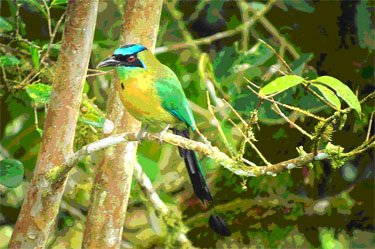|
|||||
|---|---|---|---|---|---|
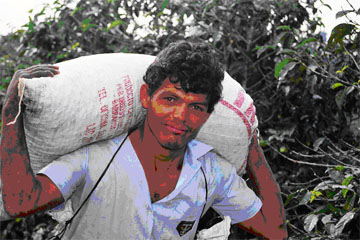 |
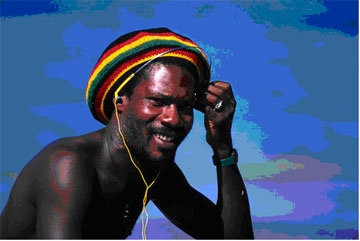 |
||||
Coffee Dude, Get a Donkey Like Juan Valdez! |
Caribbean Dude Near Cahuita Beach – Kool Hat Mon! |
Broken News
Bang
I started to write the article following this one but an explosion about a block away made me write this first.
I guess it was just a leftover firework from New Year's but it was so loud as to make one wonder if the Nicaraguans were invading again. There's no one that likes fireworks (los polveros) more than a Tico.
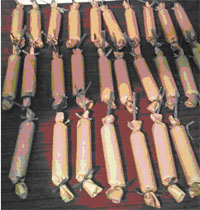 |
|---|
Quarter Sticks of Dynamite Confiscated by Police |
The two weeks surrounding Christmas and New Year's traditionally are times when explosions are frequent in the neighborhood and Roman candles regularly light up the sky all over Quepos and Manuel Antonio. To keep the populace supplied with enough gunpowder products is difficult but local merchants do their best. Kiosks and counters blossom at stores and market places all over town offering the latest in both bang products and colorful rocket devices.
I'm no expert in explosives but it seemed to me that once or twice a night during the peak holiday period I heard a bang that sounded more like a quarter stick of dynamite than a firecracker, much larger even than a super cherry bomb. Turns out I wasn't far off as a police report later confirmed the presence of quarter sticks of dynamite being transported illegally and the confiscation of dozens of unused ones (see picture).
Despite a few leftover explosions like the one mentioned above, the days following New Year's saw a great reduction in the number of bangs. The neighborhood is now largely back to normal. Goodie.
Lunch for One Please
One day at at the main beach in Manuel Antonio a couple of ROMEOS were languishing in their beach chairs in front of Mar y Sombra when we noticed a commotion behind us. People were gathering in an area near the small variety store there.
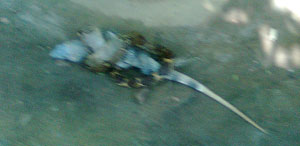 |
|---|
Boa Tightly Wrapped Around the Iguana |
A Tica told us that a boa constrictor had gotten hold of an Iguana, then fallen from one of the trees while still clasped to its prey. The boa was busy squeezing the heck out of the poor lizard. We went to the scene and sure enough we saw the two reptiles as pictured in the photo to the left. (Sorry about the quality of the photo, I moved the camera too fast)
By all appearances the Boa had already killed the Iguana but more knowledgeable people said the constrictor would continue to squeeze it's meal for some hours to come. It would then orient the Iguana so that it could swallow it head to tail in a slow muscular process, expanding it's jaw and body as necessary to accommodate the Iguana which was probably two times the diameter of the snake.
We went back to the beach and, sure enough, some time later when we were leaving to go home the two reptiles were still locked in their death embrace.
One wag standing nearby said the attack reminded him of his last relationship!
¡Pura Vida!
Roya de Cafe
The Chronicles several times has pointed out the importance of coffee to Costa Rica in articles like Coffee and Coffee Shortage. We've also reported on the newly confirmed health benefits of java in Coffee and Type II Diabetes.
 |
|---|
Coffee Rust |
Coffee production ran short of demand in 2011. Now there's a new threat to the business that is likely to reduce coffee production significantly - up to 50% in some regions. Although there are a a few large concerns such as Starbucks here in the coffee producing regions , there are also up to 10,000 small producers with limited resources who depend on coffee production for their total livelihood.
That's why the government has appropriated 2 billion colones, or 4 million dollars, to fight the disease, quite a sum for this small country.
The disease is a fungus (Hemileia vastatrix for you Latin lovers) called roya de cafe or coffee rust. It strikes the coffee plant leaves before the fruit is mature turning the leaves rust colored (see picture right) and eventually killing the whole plant. It's the curse of the coffee growing industry, not just in Costa Rica but worldwide in other coffee producing areas such as South America, Africa and Asia. In fact, the disease moved up here about 40 years ago from South America and this year's outbreak is considered the worst ever/
A certain Professor Vandenmeer of the University of Michigan, who has been studying coffee production techniques for many years says that the problem may have come about because much of the coffee is now produced in the sun versus the old method of shade growing. In the shade, healthy plants develop a second and harmless fungus called the white halo fungus that greatly inhibits roya de cafe. In the sun, white halo fungus has much more difficulty surviving.
As if the fungus problem wasn't enough, coffee producers this year are looking at falling prices and a very dry, dry season that further lowers production.
Hang in there coffee dudes, we love your stuff.
¡Solo Bueno!
 |
|---|
For some years now, with the increase in population of Chinese immigrants in Costa Rica, more festivals related to this segment of our population have emerged.
One of them has become a San José annual event: the cook-off of the biggest batch of fried rice possible. The event is sponsored by the City of San José and the Asociación Colonia China.
This ain' t rice-a-roni amigos, this is the real thing. The supporters of this festival have been making larger and larger batches of fried rice each year with a view to breaking the Guinness World Record. This year they succeeded when they successfully produced a batch large enough for 7,000 servings (that would be about one serving for each person in Quepos)..
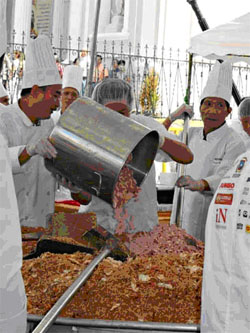 |
|---|
| Chinese Chefs Churning Chorizo |
So what does it take to produce a batch this size? Here's the recipe (divide by 1,167 if you're only having six for dinner):
- add 80 kilos (176 lbs) of eggs and scramble until they stop oozing (that doesn't sound easy to me)
- add 230 kilos (about 500 pounds) of shredded pork pieces
- add 735 kilos (1,600 lbs) of cooked rice, turning with large metal spatulas (if the batch gets much bigger they may have to consider using a front-end loader)
- add spices and flavorings: 35 kilos (77 pounds) of chili peppers, 53 kilos (117 pounds) of onions, 260 kilos (550 pounds) of chicken, 120 kilos (264 pounds) of ham and 20 kilos (44 pounds) of Chinese chorizo (sausage).
Get some muscled dudes and shovels and stir for three hours until all the flavors are melded. After seven hours of preparation and cooking, it was ready. The only step left was to get 7,000 paper plates and serve.
When the cooking was finished, a Brit named Ralph Hannah, the Guinness inspector for such events (nice job Ralph, how do I get a job like this?), pronounced the batch to be the biggest so far constructed in the world. I bet Ralph got a double helping.
Bravo Tico-Chinos, another world record for Costa Rica (we don't get many). I understand we did hold the record for a batch of Gallo Pinto but Nicaragua takes that personally and keeps coming up with a bigger batch..
Could I get some shrimp added to the fried rice and a 55 gallon drum to go please?
¡Pura Vida!
Rumble Talk
(Shaky Happenings On or About the Pacific Rim)
More of the Mediocre
For the time being our tremor-prone area seems to have settled into regular episodes of medium sized quakes in the 4 to 5 Richter range. While these are easily felt and unnerving, they rarely produce significant damage at this intensity level. Yet they are occurring regularly, to wit:
- In late January, a series of tremors in the 4.0-4.5 range hit the Nicoya peninsula, scene of the giant 7.6 tremor last September.
- Several similarly sized quakes also were felt in late January in the San Vito area near the border with Panama.
- In mid-February, two quakes in the 4.5 range also hit the southern coast in the Osa peninsula.
- There have been literally dozens if not hundreds more in the 3.0-4.0 range.
Jumping and jiving amigos, GG may get used to this yet. And if I don't it won't matter to the earth's crust anyway as it always does what it wants to do without getting the go ahead from me.
Studying the Rift
A boat load of scientists has recently been plying the waters off the Pacific coast of Costa Rica in an effort to better understand the rift that is the source of tectonic plate clashes along our portion of the Pacific rim.
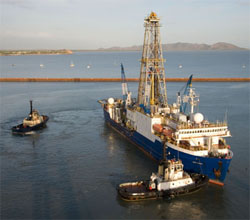 |
|---|
| JOIDES Resolution |
The scientists are housed on a ship called the JOIDES Resolution (JOIDES = Joint Oceanographic Institutions for Deep Earth Sampling). On board I bet they call it "Da Boat". The ship is equipped with mucho electronic devices and also a drilling platform that can dig deep into the earth's crust. The project is funded by the U.S. National Science Foundation and the staff come from a joint effort between Texas A&M and Columbia Universities.
They are attempting to understand the forces that are at play, those that push the heavier Cocos plate under the lighter Caribbean plate, build up tension and then result in slippage which causes the earthquakes. The researchers do this by taking core samples of magma deep in the crust and attempting to reduce the process to a set of rules or equations, that then might be used to predict future slippages.
The JOIDES Resolution has studied and continues to study the rift all along the Pacific coast from the Central American Countries to northern South America. In Costa Rica, they've done considerable work along the Osa peninsula, an area that has a relatively shallow crust, a condition that is known to produce some of the strongest earthquakes in the world.
Dudes, get the process down amigos, I would have appreciated even a 10 minute warning when the 7.6 hit the hospital in September where I was ensconced on the first floor of a ten story building pondering once more the true meaning of "pancaking".
¡Pura Vida!
Frogs con Leche
(Preserving Milk and Other Accidental Science)
Last month the Chronicles reported on an amazing natural material called propolis, a product of honeybees that contains natural antibiotic and antifungal properties.
It seems we need to learn a lot more about how our natural buddies can help us. And we modern folk usually learn these things by going back to our country cousins and watching their habits and customs.
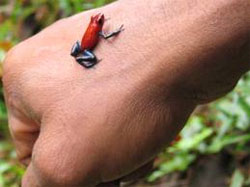 |
|---|
Poison Dart Frog |
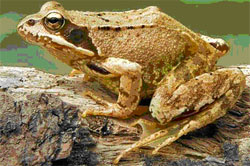 |
| Russian Milk Lover Frog - Da, Ribet! |
One of the more interesting animals to see in Costa Rica is the poison dart frog. This frog is very small (image left shows one on a human hand) but it's skin is saturated with a powerful venom that can kill much larger animals up to and including a man. The indians dipped their arrows and darts is this stuff, hence the name. Sometimes, however, poisons in micro doses can become medicines, so research continues.
On another side of the globe, country folk in Russia have known for a long time that raw milk could be preserved by putting a live frog into the milk container. We contemporaries forget that farms existed long before refrigeration was common. Without refrigeration, milk spoils relatively quickly as the bugs involved thrive on the fatty medium.
Now just how does one determine that a swimming frog could preserve milk? By accidental observation I suspect. Some dumb frog probably jumped the wrong way once and ended up in a large container of milk. Perhaps the frog died, I dunno, but the milk lived an unusual number of days. Somebody took note and started throwing more frogs into other milk containers. Real science at work (or is it applied engineering?).
Accidental scientific discoveries are not as rare as one would think. I know this from experience. I worked for a company in the 60's and 70's that was the largest producer in the world of a certain kind of engineering polymer. Two of their most important product grades had resulted from errors or accidents. One was a result of a decimal point error in the calculation of the catalyst feed rate in the reaction process (my responsibility as a process engineer but I didn't do this particular one) and the other was a laboratory accident wherein a piece of molded plastic left on the sink overnight slipped into an mild acid bath. The resulting piece. the surface etched by the acid produced the best plastic product for electroplating ever invented. These two products accounted for over 30% of company sales at one point, The company's annual revenue was over $800,000,000 when I left it in 1981.
Here are three outstanding historical examples (there are many more) of products that were found accidentally:
- Penicillin. In 1928, Scottish bacteriologist Alexander Fleming went on vacation and left a dirty work bench behind. On returning, a mold had formed in one of his uncleaned petri dishes that had cleared a wide circle of bacteria around it. Other scientists later isolated the critical substance from the mold and called it penicillin.
-
Vulcanized Rubber. Charles Goodyear (yeah, that Goodyear), a failed valve salesman who was once jailed for debt in Philadelphia, after ten years of unsuccessful experiments to modify natural rubber, in 1839 accidentally spilled a mixture of raw rubber, sulphur and lead onto a hot plate. Voila, a stiff but moldable product, now used in thousands of applications, was born.Up until this discovery rubber was brittle in the winter and sticky in the summer and of little practical use. Chuck Goodyear
Chuck Goodyear
- Pacemaker. In 1958, shortly after the transistor was invented, American engineer Wilson Greatbatch was working on a device to record a human heartbeat. He reached into a box for a 10,000 ohm resistor to insert into his device and accidentally pulled out a 1,000,000 ohm resistor, off by a factor of 100.The device was not very good at recording but did produce an electronic pulse at exactly the rate of a normal heartbeat. Le voila, the pacemaker was born.
But let's get back to the milk and frogs. What do the amphibians have that works?
Scientists have been discovering for some years now that frogs produce strong anti-microbials much like the bees do with propolis. These chemicals can kill a wide range of things that are nasty to humans: “They can be antifungal, antiviral, antibacterial, antitumor, neuropeptides, analgesics, and so on" says a professor studying the frogs at a Moscow University.
 |
|---|
A Common Peptide - The Double Sulphur in the Center Makes It a Peptide. It's Surrounded by Lots of Nitrogen, Oxygen, Carbon and Hydrogen In a Creative Design |
In this case the chemicals are called peptides (basic structure left) and some 80 versions so far have been isolated from Russian frogs alone. There are many more and different peptides on different frogs around the world to be discovered, each with a specific benefit.
These chemicals are potent in small quantities making them ideal for medicines, However producing complex structures like the one shown to the left involves manufacturing chemistry that is complex and expensive, so that years may pass before we see commercial medicinal versions in drugstores.
So if you see a frog in a bucket of milk don't be dismayed, it could be good for you. You could try and make a frog milk shake... no, don't go there GG.
This reminded me of an old joke my former father-in-Law loved to tell: A man goes for a milk bath and the attendant asks him 'Would you like it pasteurized?' The man responds 'No. just up to the neck please'. Yuk,yuk,yuk.
Ribbet.
Rating Retirement
(It's Not All About Numbers)
Somebody is always rating something; cars, toothpastes, restaurants (like the ROMEOS), hotels, beaches etc., etc. The problem is that the importance of the characteristics upon which the rating is made can vary considerably from person to person among those doing the rating. It's a very subjective thing. In addition, there can be prejudice or outright misjudgment made by those doing the comparisons.
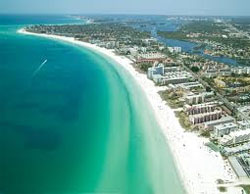 |
|---|
Siesta Key Beach (North End) |
Last year Siesta Key Beach in Sarasota, Florida where I lived for 10 years, was rated #1 beach (I forget by who) in the United States. Yet, this incredible beach doesn't even appear on the top ten world beaches rated by national geographic. They prefer to cite what they see as gems in the Seychelles and Maldives.
Now, I think Siesta Key Beach has some unparalleled characteristics that make it very attractive such as sugar sand and caribbean-like water. The sugar sand is so fine and white (99%+ quartz) that you can walk on it barefoot at the height of the day in August and not get burned. Sugar sand reflects the sun so strongly that it leaves itself relatively cool.
 |
|---|
It's All About What You Want and What You Think You Need |
But if you're a serious surfer, Siesta Key, despite all its beauty, is not the beach for you. For the old farts, like GG, who no longer wish to fight the big ones, the water "quality" is perfect but hanging ten is not in the offing. Likewise if you prefer mountains or jungle in the background rather than condos, somewhere else will beckon. The biggest hill I ever saw in greater Sarasota was about a three foot rise in the road on the way to Arcadia and that is not even close to the beach. And the picture above talks for itself about the development angle.
What you want in a retirement place is very much subject to personal likes and dislikes. International Living, a respected and interesting magazine for ex-pats and those that are thinking or planning to be ex-pats. recently published their annual index of the "top" 22 retirement places in the world. They used eight rating criteria:
1. Real Estate or the cost of buying a home.
2. Special Benefits such as senior discounts and other allowances
3. Cost of Living - a market basket of goods and services
4. Integration - ability to fit into local society
5. E&A - Entertainment & Amenities
6. Health - Quality and availability of health care
7. Ret. Infra - Retirement infrastructure, a rather vaguely defined term I guess related to easily getting
around.and also to facilities catering to older folks
8. Climate - I find this one particularly sensitive to personal taste.
According to International Living and these criteria, Ecuador is the number one retirement spot, followed closely by Panama and Malaysia. Costa Rica comes in at #5 of 22.
Here's this year's ranking according to International Living:
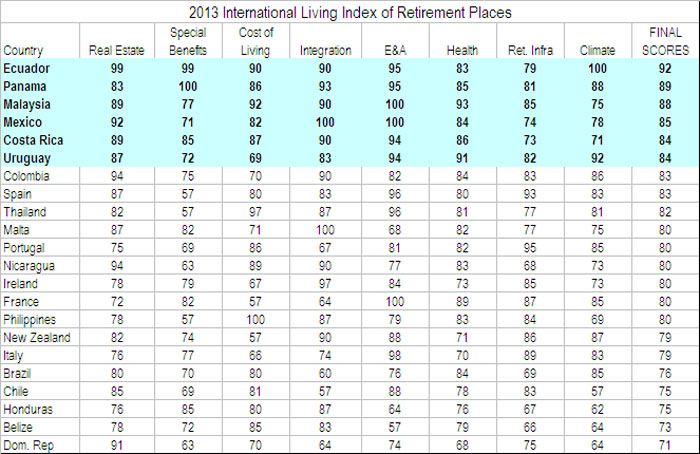 |
|---|
But here's the problem I have with the IL rating system. The overall rating is a simple arithmetic average of the eight rankings, implying each category is as important as the other. Not to me IL dudes. I decided to modify and massage the IL ranking system (killing the engineer's germ inside me is not yet complete). I call it, cleverly, GG's rating and ranking system. In doing so I will apply a personal importance factor for each characteristic; 0 means it has no value to me, 5 means it's very important.
Real Estate. In GG's revised system this ranking can be dropped (Importance = 0) as I have no intention of doing anything but renting from here on.
Special Benefits, chiefly senior discounts, are nice but not something I would base a relocation decision on. This category could easily be rolled into the Cost of Living number. Therefore I give this Importance = 0. I have no quibble about the relativity of the ranking here; Panama is dynamite on discounts, Cost Rica is pretty good but not the best by far.
 |
|---|
Cost of Living. I give this a 4 in importance, very important but not critical. I do quibble, however, with the relativity in the IL top five here. Using Ecuador as a base, and knowing what I know about Costa Rica and Panama, I would keep Ecuador at 90, put Panama at 88 and rate Costa Rica at 84. There's just no way that Panama and Costa Rica are within one point of each other as shown on the IL chart. Panama is at least 30 to 40% cheaper in daily living cost than Costa Rica and Ecuador is reported to be less that Panama
There is one other potentially significant financial factor. If you intend to travel back to the States occasionally or even frequently, the cost of the flight can be high. Based on flying to Miami, the fare (data from Kayak.com) from San Jose is $417 (I have occasionally gotten fares in the $200 range using carriers like Spirit) and from Quito $554 (it is an interesting aside to note that it's cheaper to fly from Quito to Miami than from Quito to San José ($703). If you go for the cheapest COL countries in the IL table, the added cost becomes more significant. For example; to Manila, Philippines - $1463; Bangkok, Thailand - $1569 and Kuala Lumpur, Malaysia $2159.
Integration. I'm not sure exactly what is included in this rating but I do know that a resident in Costa Rica has all the constitutional rights and privileges that a natural born citizen has, with the exception of being able to vote. And the natives are friendly. I'm going to leave this one out of the revised system also.
E&A. Aw, come on, does this mean the night clubs are better in one country than in another? My guess is that the variation between locations for entertainment and cultural activities is much more pronounced when comparing, within any one country, the cities to the countryside than it is from country to country, no matter which countries are selected. This factor is out for me also.
Health. This is the top one for me. I give it a 5. I can't quibble with the top five ranking because I don't know enough about the other countries' systems but I am a bit surprised by the Malaysian number being the highest at 93. (Aug 2015 N.B. - since the original article was written, we've learned that someone 65 and over can not signup for the Ecuadoran national health care system)
Ret. Infra. Again, I'm not sure exactly what retirement infrastructure is but if it includes walking hazards in the streets, Costa Rica would not have a high ranking. So what, watch where you're walking. I'm leaving this one out also.
Climate. I give this an importance ranking of 4. But what a "perfect" climate is, is highly subjective. Costa Rico has at least four distinct climates, chilly mountains, the cool and windy central valley, hot dry plains and hot, humid rainforest, all in one country the size of South Carolina.This feature is important to me, but for GG good climatemeans sun and sand. not mountain air. I suspect mountain air has been the governing prejudice in the IL ranking. I would also change the assessment to Ecuador - 92, Costa Rica - 90, Panama 85 (much hotter and drier there in most parts).
Other. I noticed that the International Living rating did not include anything that related to or measured safety or stability of the government. As a broad brush for crime, consider the murder rates (per 100,000) for the top six candidates (ranked by highest to lowest): Mexico - 22.7; Panama - 21.6; Ecuador -15.2. Costa Rica - 10.0; Uruguay - 5.9 and Malaysia - 2.3. (For comparison, the world average is 6.9 and the U.S. is 4.8). With regard to government stability, a long treatise could be written about these six countries which I won't do here. But I do know that Costa Rica has continuously operated with an elected and stable democratic republic for 65 years, that Mexico is relatively stable, that Panama is now stable after the dictator Noriega was thrown out over 20 years ago, that Malaysia has a high reputation for stability and that Ecuador would get a low rating in this category after having 8 presidents in the last 13 years, all elected to four year terms.
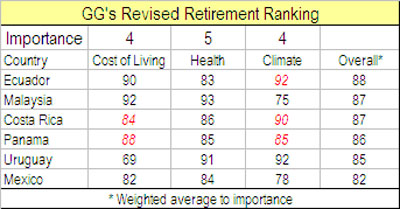 |
|---|
Making the changes noted above yields the simplified table to the left (the red numbers are the ones I changed from IL's rating). The distribution among the ratings flattens out considerably and Costa Rica, based on GG's personal ranking, now comes out much better overall, tied for second place with Malaysia.
Now there are other considerations, of course. If, for whatever reason, financial considerations force the importance factor for cost of living to become much greater relatively, the ranking would tilt towards the low COL countries like Ecuador or Malaysia. This is not an unreasonable possibility as the cost of living increases continue to be higher for Costa Rica than they do for the other countries listed.
Some will say I manipulated the numbers to give Costa Rica the edge. Yes, I manipulated them but only to re-emphasize what's important to me. Each individual needs to rate and rank the factors according to their needs, interests and desires. The best way to do this is to spend time in the country you are attracted to. GG came to Costa Rica 8 times before moving here and became comfortable with the country and the area I now live in. There were no real surprises after moving here,
As my high school latin teacher used to say: "Degustibus non disputandem est" or "There is no disputing taste", what you like is what you like and personal taste is every bit as important as financial considerations.
¡Pura Vida!
Karate Kids
(Hu - aaah, yo suki!)
In the April 2011 edition I wrote a piece called Teen Tico about a seventeen year old who had just completed high school and was going to university to study pharmacy. He happens to be the son of my landlord and he became a quick friend when I moved here four years ago because of his excellent English and sense of humor that always kept me laughing.
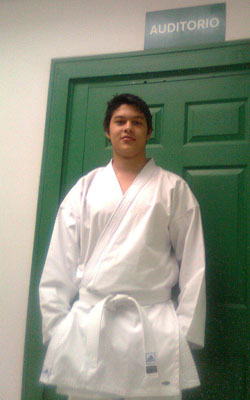 |
|---|
David Just Before His Examination |
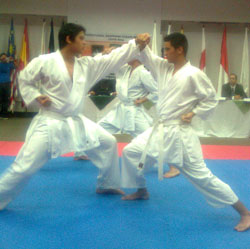 |
David In Action (Left) Taking His Exam |
David is now 19 and, like many kids when they get to college, they change their minds and majors. David started out in pharmacy science but is now studying computer engineering at Universidad Latina in Heredia, a town just northwest of San José in the central valley metropolis. I was in San José for another purpose and when I called him to say hi, he invited me to the karate examination.
This young dude is very responsible and industrious. He works 7 AM to 3 PM five days a week as a telemarketing service rep and his English is so good most people in the U.S., from where he receives the bulk of his calls, wouldn't know he's Costa Rican. (I called customer service for another U.S. based comm company recently and got what I thought was a familiar accent - I probed and the gent admitted he was in San José!) There are many call centers in San José these days.
In addition to the job, David goes three days a week from 4 PM to 10 PM to take his computer engineering classes. He also continues to play guitar in a band he started some years ago. Then there's the karate as well as continuing to play futbol whenever he can.
I was impressed with the formality of the karate examination. Their was a panel of seven judges from the International Shotokan Karate Federation that graded each student on all their moves. The leader also gently coached the kids when they needed it - very professional. There were some 25 or more kids of varying ages that were examined. They had to go through a series of moves both solo and with a partner that took about 15 minutes for each student. The evaluation of the whole class took over three hours.
David has been taking lessons only a few months and was classified a white belt at examination time, meaning a beginner. Having passed the exam, he becomes a yellow belt. I'm told the progression is white, yellow, orange, green, blue, purple, red, brown and black. The belt colors get darker as you get more proficient. Sounds like a lot of work to me. There are also 10 degrees of black belt and. if you reach the 10th degree back belt and practice karate 40 years or more, you become a Grand Master (like Chuck Norris).
Two weeks after the event, David learned he had passed his exam and he received his cinturón amarilla (yellow belt). The next step, green belt, will take up to six months to complete.
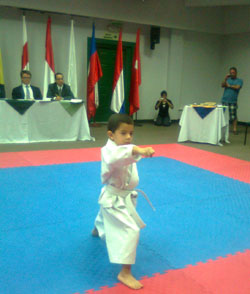 |
|---|
Juancarlo - 4 Years Old - Yo suki! |
The class was made up of kids of all sizes and included three or four girls. David is the tallest in the class. There were two medium sized guys, identical twins, that were sporting dark belts who served as assistants to the judges organizing the students and as partners to the examinees when required.
But the guy that stole the show was a little white belt dude named Juancarlo (see picture right). He's only four years old, yet he went through all the exercises that the big people did. Most of the judges and the people in the audience were doing everything they could to control their smiles and trying hard to be serious for this bantam weight. There was a strong outburst of applause when Juancarlo finished his routine and bowed to the judges. Well done, JC.
After the exam GG went to lunch with David and his dad in the university cafeteria. David introduced me to his "Sensei", a kind of sponsor or advisor who helps him when he is in training. The Sensei to David's Sensei is the advisor's dad who also happens to be one of the judges. When a Sensei addresses a student the student is to respond "Oss!" out of respect.
It was a very enjoyable way to spend a Saturday morning.
Oss! Kiai - suki!!!
What's-in-a-Word
More Bilingual Banter
The studies continue to roll in about how being bilingual can be an advantage to mental acuity. Last month the Chronicles pointed out in Growing Your Brain that researchers in Sweden reported that intense language study actually causes physical changes in parts of the brain and that it makes it grow.
Hot on the heels of that study comes another one from the University of Kentucky College of Medicine which concludes that "...seniors who are bilingual do not need to expend as much effort, and yet they still out-perform their monolingual peers, suggesting that they use their brain more efficiently.”
Good to hear but it raises other questions in my own mind. Do you mean to say that, had I not learned a smattering of French years ago and some Spanish in recent years that my brain, both in memory and acuity, would be even more troublesome than it is now?
God help me, s'il vous plait, por favor.
Estupido
Regardless if you don't need to or don't want to speak Spanish, even the most casual observer quickly learns that many "s" words in English become "es" words in Spanish, sometimes with a minor change in spelling.
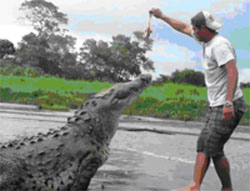 |
|---|
| Definition of "Estupido" |
Consider for example:
escena (scene)
escolar (school bot or girl - scholar
escorpión (scorpion)
espacio (space)
espiritual (spiritual)
And there are many more "es" words in Spanish but one of my favorite is "estupido".
Of course it is easy to directly convert this word to the English equivalent but my Spanish dictionary did better than that, it also provided a pictorial definition of this important word (photo to the left).
Looks like another tourista on the loose again.
¡Pura Vida!
ROMEO Corner
(Retired Old Men Eating Out)
Dragonfly - Manuel Antonio (This restaurant closed late 2014)
Location: Main Beach Manuel Antonio. Second Floor Near the Pizza Place
Hours: 11 AM to 11PM, Monday thru Sunday.
Parking: None reserved for this restaurant; street parking not as difficult at night as during the
busy beach day; a pay lot is nearby.
Contact: Tel.: 2777-4139; Email: websilver@yahoo.com;
Reviewing ROMEOS: Brian M., David H., Hal H., Bob N., Jim M., Anita M.
To Review Our Rating System and Procedure, go here: R.O.M.E.O. Rating System
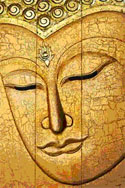 |
|---|
This is a new restaurant in Manuel Antonio, right on the beach, that bills itself as Thai cuisine. Three of the ROMEOS had eaten here before, so this represented the second pass except for one for which this was his third time. The dining room is open air and presents a good view of the sunset from many of it's tables if you get there before 6 PM. The decoration is in red accents with a few pieces of Thai art spread around the room and on the walls.
The tables are either large and round that seat four, or smaller and hour-glass shaped that seat two. The wedge shaped seats are padded (yeah!).There is a large horseshoe shaped bar and happy hours are promoted daily. We came to understand that on this visit, a Thursday night, is ladies night and music (a bit too loud for dining) was being offered.
The serving of a small wet towel to each guest for refreshment at the start of the meal is a nice touch.The menu offers a good selection of Thai specialties with maybe a minor Tico influence in some dishes. GG's first experience here had been with their cashew chicken that had a wonderful, delicate sauce and included fresh crisp vegetables with jasmine rice. One of the ROMEOS on this visit chose the same for a main course and pronounced it excellent.
Four of the ROMEOS had an appetizer; one had spring rolls, another a shrimp roll up and still another had a Thai version of fried won ton. All was judged good, GG misread the menu because it deemed the Pad Thai was listed on the same page as the tapas and I thought it was being offered as an appetizer. Not. It was a main course and I had to take more than half back to the casa for lunch next day (very tasty combination of noodles, peanuts, scallions and shrimp in a lightly sweet and lightly picante sauce). For main courses we had fried rice with shrimp, a red curried chicken, the chicken with cashews and a filet of mahi-mahi cooked in a banana leaf. The interesting thing was that three of us who had eaten there before and found the dishes flavorful and excellent all reported less flavor this time. I had talked with the restaurant's owner about the mahi-mahi and he told me it would have a Tico touch with a black bean paste. That's not what was served and the fish, one type that I like a lot, was a little too plain this time. |
 |
|---|---|
$ $ $ $ |
|
Value Index = 100 |
Be advised also that no postres or desserts are offered on the menu. There is an Italian heladeria located on the first floor below the restaurant for those that just have to have something sweet after dinner (e.g., GG).
The service was very helpful, prompt and courteous. In fact, for this area, the amount of time required to prepare each course was considerably less than most restaurants for this quality and type of food..
Three of us had been excited to come back to the Dragonfly after our earlier experiences and were thinking we'd probably give the place a five sloth rating for atmosphere, food quality and service but the experience with the food and music on this night put a little tarnish on the rating and we ended up giving the restaurant four sloths as a composite for the two to three visits we've made so far.
GG's two main courses and two soft drinks ended up being billed out at $39 including tax and mandatory gratuity charges. The others, each with an appetizer and main course and soft drinks came in at $20-25. That puts Dragonfly at the high end of the four dollar rating and with a Value Index of 100 which puts it in the middle third of our rankings.
Location: Top of Manuel Antonio hill across the street from the Latitude 9 Realty Office
Hours: 11 AM to 10 PM, Closed Wednesdays, Reservations NOT Accepted
Parking: Seems adequate directly in front for the size of the restaurant.
Contact: Tel.: 2777-5280; Email: N/A; Website: http://www.cafeaguaazul.com/
Reviewing ROMEOS: David H., Brian M., Chris F., Jim M., Bob N.
To Review Our Rating System and Procedure, go here: R.O.M.E.O. Rating System
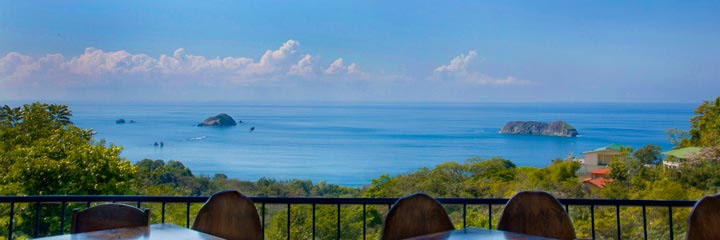 |
|---|
| View from Agua Azul Dining Room (Get Here Before 6 PM to See This) - Elephant Island to the Right |
This is one of the smaller restaurants in the area (seats about 25) but very popular, particularly among tourists. It is located at the peak of Manuel Antonio hill and offers the best scenic view of the Pacific and the rock islands just off the main beach of any restaurant on the hill.
The dining room is simple, a bit crowded with tables and is essentially employs the Tico formula for simple hard wood tables and chairs/ The tables are unadorned and the silver ware is wrapped in paper napkins. There is very little decoration anywhere but the view of the Pacific makes up for all that. All the food is prepared behind a counter in one corner of the room that also serves as a bar.
The menu has a broad sampling of appetizers, sandwiches and main courses of meat and fish suitable for both lunch and dinner. In addition to the menu list, a few specials were offered including a pasta dish of meat lasagna which is what GG chose. The dish was tasty but the pasta was quite soft, a bit overcooked. It was served with a simple salad similar to a cesar. One ROMEO ordered a Thai spring roll appetizer that was very fresh and tasty. For main courses, other ROMEOS had a filet mignon (*tasty and a bit chewy"), a barbecue chicken sandwich ("good), a breaded fish ("good but could have used a little more ginger") and fajitas ("good"). Dessert offerings were limited but enough of a selection to allow the group to sample a chocolate cake, a brownie and a bread pudding. All were served with vanilla ice cream and were deemed good. |
 |
|---|---|
$ $ $ $ $ |
|
Value Index=80 |
Service was friendly and relaxed and we had a waiter who ended up joking with us quite a bit making the meal more fun. The time from order to receipt of the food was quite reasonable considering the place was full.
For atmosphere, food quality and service we gave Agua Azul a composite score of four sloths. Total bills (the menu prices do not include tax or service - add 23%) and ranged from about 12,000 colones ($24) for the chicken sandwich, brownie and a soft drink) to 25,000 ($50) for the spring rolls, filet and chocolate cake. For GG, the bill was just shy of 18,000 colones ($35) for the lasagna, bread pudding and two cokes. This puts Agua Azul at the top dollar rating (i.e. top 20% most expensive in the area). It also gives them a Value Index of 4/5x100 = 80.
Most of the ROMEOS had eaten at Agua Azul before and stated that the food continues to be good, if a bit pricey for the type of offering. It remains a good option for diners, local and tourist alike.
don Beto de Quepos, El Gringo Dorado Pura Vida! |
Be pithy but kind. I'm sensitive. |
|---|
